Espacios. Vol. 36 (Nº 01) Año 2015. Pág. 4
A Comparative Analysis of Penitentiary Management Systems in Chile, Spain and the United Kingdom
Un análisis comprativo de los sistemas de administración penitenciaria en Chile, España y Reino Unido
Guillermo Javier DÍAZ VILLAVICENCIO 1; Maria Fernanda ZUMBA ZÚÑIGA 2; Simone DIDONET 3; Paul M. CAHEN 4
Recibido: 09/09/14 • Aprobado: 11/12/14
Contenido
1. The Penitentiary System: Characteristics and Management
ABSTRACT: |
Introduction
The objective of this research paper is to compare the management of three prison institutions within the same sector of social investment, but which are also engaged in different macro territories. It examines the Penitentiary Service of Chile and its counterparts in Spain and the United Kingdom. Certain structural variables from each of the three countries have been considered, such as the evolutionary economic background of Public Services during the years (2000- 2008), as well as the pertinent background details of the countries that comprise the Organization for Economic Cooperation and Development (OECD).
The penitentiary organizations or systems that are mentioned in this study possess similar structural characteristics and seek the same objective, or mission, which is to guarantee the effective implementation of preventative detention, and to develop inmate assistance programs that reduce the likelihood of re-offending. Although this appears to be a simple task, the nature of human capital implies that this is also an activity that is immensely complex. Indeed, one could go as far as to say that it may even be socially questionable seeing that many prisons represent the last course of action in administering justice in any given society.
Spain, England and Chile are countries with common cultural foundations, as well as similar legal and penal systems. In this regard, it could be said that these countries possess a vast body of legal information concerning the types of crimes or criminal offenses that occur within a given society. On the other hand, there is a certain homogeneity with regard to the occurrence of specific crimes. For example, their legal courts seldom deal with crimes such as people trafficking- i.e. to the same extent as other parts of the world. Neither is there extreme prejudice against women such as that which occurs in the Middle East. Nor is there child exploitation like in Africa and India. Nor is there the same level of sex trafficking as in other countries (Thailand, Colombia, Mexico), or kidnappings, of terrorist acts, or drug trafficking . Within the different categories of crime that are listed in this study, we noted that there are some important similarities. Hence the reason why there is a certain level of homogeneity among them. For example, in Chile as well as in Spain and the UK, the types of crime that is most worrying and the most frequent is theft (assault or burglary, which is accompanied with or without violence), vandalism, vehicle theft, drug trafficking, petty theft, driving under the influence of alcohol, swindling or fraud, among others.
With these similarities and differences in mind, this study aims to compare the three countries cited earlier (Chile, Spain and the UK), and their respective social economic investment. In this way, we can obtain an evaluation that will help us to better understand the phenomena that influence prison management. In this regard, economic practice is viewed in terms of financial and social investment, that is, it looks at how money is spent and whether social investment can be justified or not. The objective, then, is to provide a review of that which occurs in other Ibero-American countries and to highlight both commonalities and differences -i.e. with the ultimate goal of shedding light on the state of the art in this field.
This study begins by looking at the general context of the research. It provides the characteristics of various penitentiary systems in different prisons. This is followed by an analysis of the objectives and the methodologies that are used. After that there is a comparative-quantitative analysis of the selected variables. Finally, there are conclusions based on the results that have been obtained.
1. The Penitentiary System: Characteristics and Management
Generally speaking, we can divide prisons into three main groups: public, private and mixed. Among these three public prisonsare known to have a bad reputation, poor infrastructure and major problems with prisoners (human rights, lack of food and overcrowding). There are a few exceptions, for example, in specific cultures and countries, where greater effort is being placed on social rehabilitation (Cabral and Azevedo, 2008).
Private prisons can be found all over the world and can be a very profitable business for specific economies (Lambert and Paoline iii, 2008). For instance, the Corrections Corporation of America (CCA) is responsible for the private management of more than 64 detention centers. The results for the first trimester of 2009 show that cost per detainee per day amounted to $40.90. This figure demonstrates the efficiency of CCA prison management. Conversely, the daily cost of $65.00 is spent on each inmate in public North American prisons. This latter sum reflects the fact that the United States saves its state funding bodies approximately 40% in this field, despite the fact that these prisons are privately managed (Valdemoro, 2009).
On the other hand, in Brazil, we can find mixed prisons (Cabral and Azevedo 2008), which, on the outset, seem more like the private prisons in Chile. In terms of effectiveness, it could be said that the semi-private prisons in Brazil are similar to those in Chile, whereas the "mixed" (private and public) in Brazil are similar to the private (subsidized) Chilean prisons, i.e. where the roles of security and post rehabilitation are shared to achieve objectives (CESC- 2006).
In as far as the management of the penitentiary system, which directly affects inmates, we ought to view this situation in light of current laws. It is here where we find a series of principles that are being implemented for the protection of all persons that are subjected to any form of detention or privation of freedom. For instance, the Charter of the United Nations [5] in the Universal Declaration of Human Rights; the International Pact of Civil and Political Rights; and the Convention against Torture and Other Cruel Treatment or Inhumane or Degrading Punishments. All this is of grave international concern in terms of the inmates' livelihoods, especially in terms of their rights and any action that is carried out by the management. In addition, it is important to mention the institutionalization of penitentiary management based on the principles of North (1990).
2. Econometric Models
While reviewing the material, we observed a number of case studies concerning the economic analysis of crime. Upon reading these studies, it was possible to locate an optimum point, i.e. where we could measure the applicable economic techniques with real occurrences of crimes. Here, it was possible to apply the theories and the techniques proposed by the Nobel Prize winner, Gary Becker (1968). Becker's studies, which were at the time very advanced for his era, help us to understand the complexity of penitentiaries in different areas. For example, we can determine the number of crimes that are committed within a said community (depending on the external variables), and how these crimes would reflect the current situation within penitentiaries, i.e. from the point of view of the number of inmates, the classification of inmates, associative costs, and types of prisons, etc.
Becker (1968) argues that a criminal is a normal person 'like everyone else', and he or she assumes individual and rational behavior. In this regard, the economic theory of crime takes into consideration illicit behavior by means of a process of rational selection. For this reason, the economic agents – who are potential law breakers – value the expected costs and benefits of alternative courses of action according to a pre-determined usage function. (Bandres y Diez-Ticio, 2001).
In general, the tested model creates a decision analysis of the individual, which is founded on the distribution of time between legal and illegal activities. In this way, legal activity generates some positive performance, which will depend on the amount of time that is dedicated to it, and also the illegal activity of other positive performances, but this will depend on whether one of the possible states have occurred, i.e. 'of being or not being detained' (Ehrlich, 1972).
According to Martin and Navarro (2007), economic models occur as a result of considering the 'maximizing behavior of the criminal' (their income, the usage of these funds, and the overall well-being of the individual), stable preferences, unbiased expectations, that is, accepting the notion that there are no differences between the subjective evaluation of probabilities on behalf of the criminal and those that are real probabilities. Furthermore, there exists a market equilibrium that facilitates the application of offers and demands in the crime market- a concept of crime that illustrates measurable, negative external effects and behavior, and which subsequently acts as a deterrent of criminal activity". The above authors observed that to accept this theory of criminal behavior, it is necessary to analyze it from the point of view of a theoretical premise, which does not always reflect what happens in reality. The first premise is that he or she has 'perfect information'- a situation that is not very common in criminals that occasionally commit crimes, or those that commit crimes only once. In an ideal situation, the individual would have to evaluate all the costs and the benefits. The second premise is that the individual is free to choose. This situation is equally paradoxical because the current situation of Latin American prisons indicates that the number of inmates is characterized by a poor level of education, but is viewed within the context of severe social inequality. For this reason, it is fairly common that the option of "not committing a crime" does not really enter the category of personal liberties, but rather that the individual acted as a result of using their personal will and without taking into account either their moral or ethical convictions concerning the crime itself (because they need to survive).
The prison sentence will likewise depend on the time dedicated to illegal activity. Moreover, it will depend on the severity in which the law is applied (Bandres and Diez-Ticio, 2001). This leads us to the need to evaluate economically and socially the investments made within the field of prison management. What's more, it may be empirically argued that there are certain illegal acts that unite the prison realities of the three countries in this study- seeing that the institutions themselves opt for the detainment of criminals, and aim to create an effective system for rehabilitation.
Nevertheless, the basic econometric models proposed by Becker have been counter-argued by various authors. One of the main proponents of this contrasting view is Gibbons (1982), who demonstrates that the econometric model does not fully justify the faith that his followers have in him (Becker), and that no significant contribution is produced in terms of criminology theory, and that only a general foundation for penal studies is provided (Campos, 2008). The latter is discussed in our study in terms of social-economic investments.
Similarly, (Entorf and Winkler, 2008), who base their studies on a data panel from Germany, highlighted that the models only take into consideration data on crimes, and do not include factors that lead to criminal acts. They show for example, that drug addiction is an important factor when analyzing the increase in crime.
After reading the above statements, we should ask ourselves the following questions: What can we compare between countries? How can we compare ourselves with other institutions? Why do we need to compare ourselves?
3. Methodology
3.1 Date Sources:
In order to carry out prison comparisons, a number of reports, academic papers and websites were examined: periodical reports of King's College, London, and the International Centre for Prison Studies [6]. Also, data was compiled from the Council of Europe (CoE) – an organization which consists of 47 member countries from the European Community. [7]
For data on the United States and Great Britain, however, the National Criminal Justice Reference Service (NCJRS) was referred to, which is managed by the Justice Office Programs – part of the US Department of Justice [8]. In addition, data was gathered from the Center for Employment Opportunities (CEO) [9], which runs the Public Services International Research Unit (PSIRU) at the University of Greenwich, London, England. [10] Similarly, a number of various professional bodies were examined within the Global Altus Alliance such as the Centre for Studies in Public Security (CESC) [11], the Vera Institute of Justice [12] (New York, USA), the Centre for Studies in Security and Citizenship (CESeC) [13], Brazil, and the INDEM Foundation [14], the latter of which is dedicated to information science for the democracy of Russia.
While reviewing information in international databases, it was determined that there was a lack of positive results with respect to the financial management of prison investment.[15] Nevertheless, a significant number of papers and/or studies specifically discussed comparisons within the field of the social/economic management of prisons. References were obtained from revisions and/or comparative evaluations of the management of justice and/or comparisons in the administration of public/private prisons, such as the case study by Cabral and Azevedo (2008). In addition, analyses were carried out concerning the perceptions of inmates and prison staff, the administering of prison sentences, e.g. as described in the research carried out by Hancock and Raeside (2009). In a similar vein, an analysis was conducted concerning the scope of the protection of rights of incarcerated people, such as the paper by Francia (2006). Notwithstanding, this is an article that reflects more a voice of protest than an actual situational diagnosis.
Within this context, it is important to stress that the Government of Catalonia's Secretariat of Prisons, Rehabilitation and Juvenile Justice (Spain), has created online access to a number of institutional reports and materials: the CD of the Department of Justice, Government of Catalonia. (2007); a basic statistical information bulletin, published consecutively; and penitentiary services, rehabilitation and juvenile justice reports by the Catalonian Department of Justice, 2009 (online version).
The scientific research journals that were considered included such sources as International Criminology and Penitentiary Studies, the Prison Journal, the British Journal of Criminology, Social Science Research, Social Science Journal, Federal Correctional Institute, Mental Disorder and Crime, Journal of the Royal Statistical Society, Criminal Justice and Behaviour, Psychology, Public Policy and Law, American Journal of Criminal Justice, Criminal Justice Review, Revista Española de Investigación Criminológica y Debates Penitenciarios, among others.
Among the scientific journals found, we can conclude that the information reflects current practices in this field (prison management, penal law, criminology), and that a significant number of the journals is focused on mental health sciences and the social re-adaptation of inmates. However, it was not possible to obtain a highly varied study with respect to the economic and social management of penitentiary investment resources.
Moreover, the actual data that were compiled for this research were neither considered to be of high impact, nor were they detailed. With regard to the more general information that was obtained, our work was limited to carrying out a more global analysis of the situation in both key countries (Chile and Spain). Consequently, we could only reach certain conclusions and establish what the scope of the problem was within specific descriptive parameters, that is, from a statistics perspective.
For this reason, our research in this field was more geared more towards a descriptive approximation – and did not take into consideration other options such as inferential studies. This latter can only be carried out in cases where it is possible to combine the variables with more detailed contents.
3.2. Research work
During the writing of this research paper, we were able to provide answers to theoretical questions by means of the observation and analysis of data. In this way, it was possible to describe the current situation of the chosen field (namely penitentiary systems of the three countries in this study). The design and/or model of research used was descriptive. Essentially, this means that it was based on secondary information that was created as a result of the revision of digital archives, reports, public documents, papers and studies that are directly related with penitentiaries in Chile, Spain and the UK.
The proposal that has been adopted for this research paper is therefore of a quantitative nature, i.e. where an analysis of the research problem is performed as an approximation of previously posed questions.
This research model thus proposes some basic steps that should be taken. In this regard, the overall context of the study was analyzed. This was followed by the devising of informative questions, the gathering and revision of information, and an analysis of the country comparisons. Finally, we compiled all the results and wrote up the conclusions.
3.3 Variables
The variables were established during the reading of the paper and directly corresponded to the gathering and revision of information. Based on this process, it was possible to obtain the following information: 1) Population of each country (Table 1); 2) Number of inmates per country;3) Total expenditure in US dollars (social investment) per country on prisons (which was done for each year of the sample) [16], and 4) the estimated figure of inmates who receive certain benefits within the penitentiary system.
In addition, basic information was obtained from the Organization for Economic Cooperation and Development (OECD), i.e. seeing that Chile, the UK and Spain are aligned with the parameters of this international organization.
Among the variable that we studied were factors concerning the 100,000 inhabitants (for each of the three countries), as well as factors related to other excluded parts of the population, that is, according to various international bodies. The references are presented in the table on the next page.
Variables used in the study
Country |
: |
Countries studied: (Spain, Chile and United Kingdom) |
Country population |
: |
Total population, statistic bases of the National Institute of Statistics (NIS) in Spain, Chile and the UK. |
Inmates |
: |
Spain (Council of Europe's Annual Penal Statistics- SPACE 1, 2009), Chile (compendium of population statistics – by the Chilean National Guards in boxes 4 and 6); UK International Statistics on Crime and Justice, UNODC (2000-2009). |
Cost (US$) |
: |
Spain (General State Budget 2000/08 – Economic and financieros) – Chile Integral Management Balance Sheet 2000/08 Chilean Gendarmerie)/ Types of change of the Central Bank of Chile, and the Bank of Spain/statistical bulletin. Type of nominal change according to period (Excluding investments in infrastructure). International Centre for Prison Studies UK. |
Number of inmates |
: |
(Ratio/Inmates) per 100,000 inhabitants* |
Investment per Inmate |
: |
(Expenditure/inmate) |
Inmate population with benefits |
: |
Probation of all three countries: Spain, Chile and the UK. |
Benefits per 100 inmates |
: |
Average rate of benefits per country (probation per every 100 inmates) |
*Ratio utilized by King's College London, International Centre for Prison Studies
Source: The author
The period of analysis was from 2000- 2008 (nine years). Unfortunately, due to the pertinence and lack of information that was gathered, it was not possible to extend the time frame. On a more positive note, the period commenced with an historical event that occurred in Chile: the period when the Penal Process Reform began. In the case of Spain, however, there was a general revision of the penal system and crime fighting policies for fighting- producing as a result the negative diagnosis of the Spanish penal system. For the UK, however, we can see that there were not any major legal or structural changes in prison policies. Therefore, with this information at hand, we were able to propose a formula to measure the gap, which was calculated as follows:

Where:
B is the gap
x is Chile's investment for each inmate
y is Spain's investment per inmate; and
t is the study period.
4. Results
4.1 General aspects
In Table 1, the results reflect the data that were obtained for each year and for each country in the study.
Table 1: Data obtained for the period 2000-2008
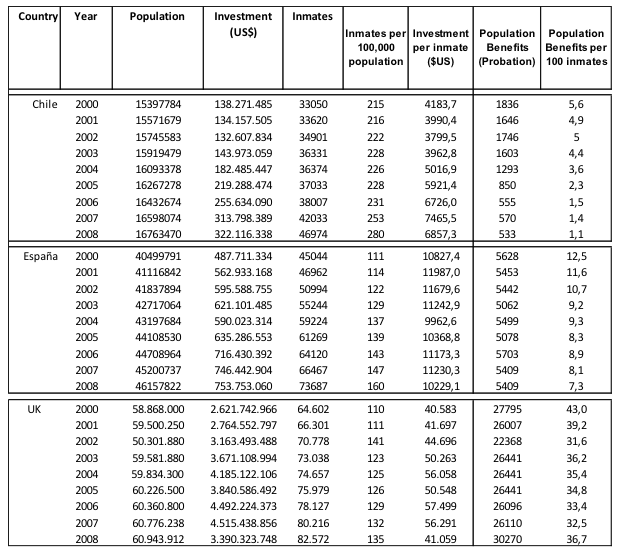
Source: The Author
The nine-year study (2000-2008) helped to create a data panel for future research, which was based on statistical inferences Didonet, et.al (2012). For the purpose of the current research paper, it was determined that the number of variables gathered for the study was insufficient to create a level 2 comparative analysis.
Based on the above information we can conclude that Spain has an unequal level of investment for 2004, despite the fact that the number of inmates continued to increase. This situation appears to be related to a change in state policies that was implemented in 2003 (this point will be discussed later). In a similar vein, for the period 2005-2008, and for the case of the UK, there was a decrease in the level of investment, which is attributable to the need to obtain greater efficiency in terms of expenses (despite the fact that the number of inmates increased). Nevertheless, we can observe a more positive performance, which is reflected in 2008, with lower costs per inmate (18.6%).
Table 2: Descriptive statistics of the sample

Source: the Author
For comparison purposes, Typical Deviation (TD) or Standard Deviation (σ) was used, which is a centralization or dispersion measurement performed by reason variables (ratio or quotient), and intervals, which is of great use in descriptive statistics Newbold (1998), Didonet, and Díaz (2012). Therefore, the greater the level of standard deviation, the more dispersed the data are in relation with the average. This indicates that there are major variations in the data.
It should also be highlighted that the SD of the variable "Inmates per 100,000 inhabitants" is not very disparate among the three countries in the sample. This demonstrates that the countries have experienced a continual increase in the averages of these variables, except for the UK where the Standard Deviation figure is lower in Chile and in Spain.
The SD investment per inmate (calculated in $US) indicates that there were major fluctuation, especially with regard to Chile (which was twice as high as the figures for Spain) and with the UK (which is four time as high as Chile). In this analysis, this implies that there have been various events (increases or decreases in investment), i.e. among the time intervals during the period of the study.
The Standard Deviation (SD) of the benefits for every 100 inmates was very similar for Chile and Spain. This indicates that both countries experienced similar trends during different intervals. In addition, it implies that there exist some common practices when taking political decisions, namely those regarding the actions that are taken by both countries for a particular variable. In the case of the UK, the figures are triple those of Chile and Spain. This indicates that there was a continual rise in the number of benefits that are received by inmates (calculated as a ratio of 3:1).
With regard to the last variable (investment/inhabitants), we observed that Chile received a typical "dispersion, which was four times as much as Spain. This seems to denote – in the first instance- that the dispersion was considerable. In terms of the study, this shows that Spain does not have a severe dispersion for this variable, but rather that it reflects a constant variable in terms of its distribution, and denotes a maintenance policy of the system that has minimal requirements. In the case of the UK, the reality is higher than the previous countries – seeing that its policies reflect a real concern (constant) in the field of investment per inhabitant, which is almost triple that of Chile's investments.
In general, the results show that the TD (Typical Deviation) for Chile – compared with Spain – is greater in the four variables shown. This indicates that during the selected period, Chile showed severe "fluctuations" during the said intervals, thus creating a global situation that was a little more favorable than Spain in real terms.
The reality of the figures in the UK – compared with those of other countries – is clearly evident if we take into consideration the low population, the high level of prison benefits, and the high level of real investment- leaving Chile and Spain behind in terms of real investments in economic and social fields.
The data gathered from this study may lead to the creation of different comparisons from the perspective of quantitate analysis, which is discussed below:
4.2 Comparisons:
a) Inmates per 100,000 inhabitants (Chile, Spain, UK, and OECD countries)
Graph 1 shows a comparison of the number of inmates per country – according to ratio of 1000,000 inhabitants (in line with international studies).
Graph 1. Inmates per inhabitants
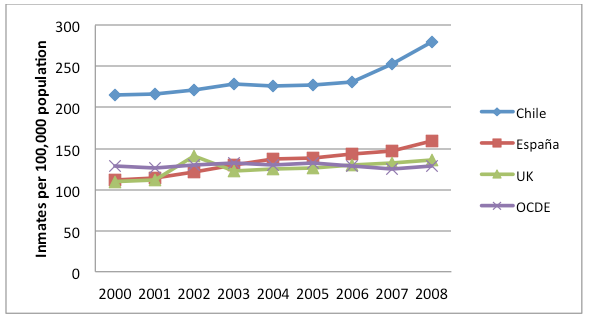
Source. The author
The OECD data used in this study were for 22 out of the 50 countries, (excluding Spain). It is important to highlight that the reduced numbers of the OECD (22) reflects the fact that not all the OECD countries had information available for the nine years of this study (see annex 1).
Notwithstanding, we may conclude that both Chile and Spain experienced a similar increase in the number of inmates, resulting in a stark contrast with the figures for Chile, especially over the last few years. On the other hand, the figures for Spain were a little more than half of the OECD for 2004, and have remained steady with regard to the total number of inmates. Subsequently, it may be inferred that one of the key reasons for this increase in both Chile and Spain was the number of foreigners who have been detained, plus the use of mechanisms that help former prisoners to reenter society – a mechanism which appears to be somewhat ineffective and merits further analysis.
With regard to the increase of inmates in Spanish prisons, the Criminal Policy Study Group (GEPC) elaborated a project in 2003 for Spanish Penal System Reform, i.e. as described by Cid (2008). As Cid (2008) suggests, there is little usage of social reinsertion mechanisms in Spain, which also leads to Spain's relatively high incarceration rate, that is, compared with countries in the European context. More specifically, Chile has a high rate of incarceration, which leads to the natural conclusion that it has a higher number of inmates per 100,000 inhabitants, compared with countries such as China and the United States.
In the case of the UK, the reality of the situation points to the fact that the figures were approximately half of those of the OECD. In this regard, the UK plays an important role and constitutes a typical example of the OECD. Therefore, it could be argued that its current situation within this variable may indicate that its trend is normal – together with that of Spain.
b) Inmate expense per year for each prison institution: Chile, Spain and the UK ($US)
The cost/ social investment of the three countries shown in Graph 2, i.e. where the total direct investments of each country and each penitentiary institution are shown in US Dollars for each nominal period [17].
Graph 2. Number of Inmates per Year
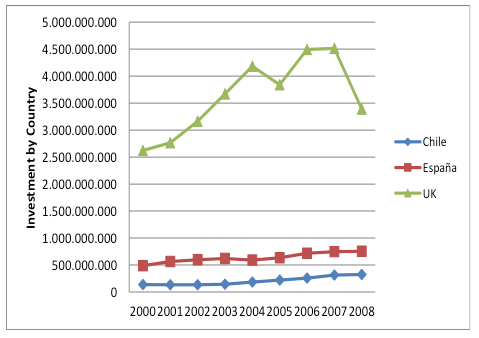
Source: The author
Over the last nine years, the increase in the financial resources used for prison management was 233%. Whereas in Spain, there was an increase of 155% during the said period (more details can be found in Table 1). For the UK, however, the increase in financial resources for prison management was 129%, which gives it the lowest figure within this study.
If we analyze this situation more deeply, we can see that there exists an important economic "gap". The relevance of this economic gap ties in closely with the principles adopted by the Central Bank of Chile- namely that it is being adapted especially for this study, e.g. as stated by (FUENTES, GREDIG and LARRAIN, 2008). Moreover, the above authors highlight that the "production gap" is defined as the difference between the effective and the potential level of a country's economic production. Therefore, for this study, we have taken into consideration the effective rate shown by Chile – and the potential level of productivity for Spain (as a preliminary analysis). In the second table we have only placed Chile and the UK - bearing in mind that it is only referential within a specific economic context.
c) Investment Gap in Inmates per year/country ($US)
Graph 3.1 and 3.2 reflects the social investment gap of penitentiary institutions in Chile and Spain, and the initial costs of each country per inmate. Inmates from the "open" and "semi open" category from the three countries in this study have not been included.
Graph 3.1: The Investment Gap in Prisons – Chile and Spain (2000 -2008)
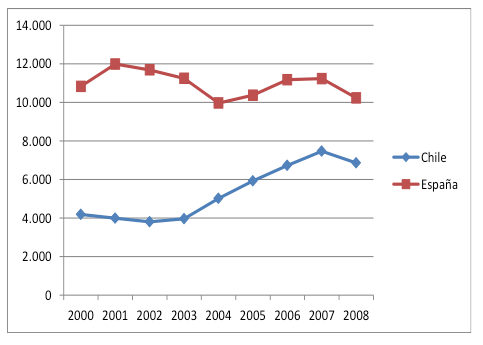
Source: The Autho
----
Graph 3.2: The investment gap in Chile and the UK (2000-2008)
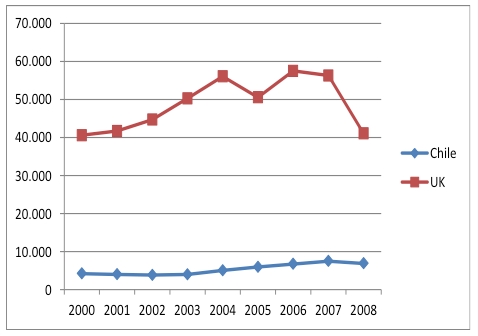
Source: The Author
Although Chile considerably increased the expenditure per inmate by 164% (from 2000 to 2008), Spain maintained a structural expenditure per inmate within a pre-determined range (10,000 to 12,000) during the same period. The increase in the number of inmates last year created a reduction in average investment per inmate, i.e. for the Spanish case study.
On applying formula [1] to identify inmate expenditure in each country, a gap in expenditure (in US Dollars) appears between 2000 and 2008, which can be expressed as a real reduction of that figure. In this way, we get closer to the figure of the previous year of the study. Hence:
The gap between Chile and Spain reduced by an average of B= 49%
In the case of Chile and the UK, the gap reduced by an average of B=11%
The previous figures demonstrate Chile has invested more heavily a strong increase in financial resources per inmate – with current investments amounting to an average of half of that, which is being invested by Spain for each inmate. In real terms, the gap for 2000 was 61.4%. Whereas for 2008, it reflects a gap of 33,1%. Chile maintained a remarkably high figure of 11%, which was mostly consistent over time. The threshold which should be followed in the long-term is therefore the UK.
d) Investment per inhabitant of each country
After a brief analysis of Graph 4, we can see that Chile invested more heavily than Spain at the socio-economic level.
Graph 4: Investment per Inhabitant
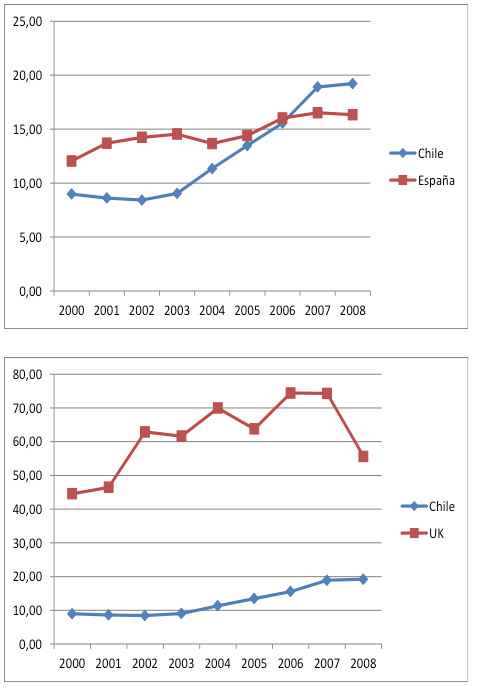
Source: The author
In 2008, the figure for Chilean investment was greater in nominal terms than in Spain, i.e. with a figure of $US 2.89 per inhabitant. This supports the theory that Chile has made a very significant investment since 2002 in terms of prison investment per inhabitant, (i.e. when comparing Chile with Spain).
In the case of Chile and the UK (the comparisons of their figures), we can see that the UK invests $36.41 more than Chile for each inhabitant. This reflects a major difference in terms of real investment.
Based on this evidence, it is worth bearing in mind the concerns of the Chilean State in this subject matter, which is, conversely, largely neglected in developing countries. For instance, during the first decade of 2000, Chile was emerging from severe economic inequality, which was mostly caused by the military dictatorship. Today, with Chile's more democratic role and thanks to the economic reforms of previous administrations, it has become more aligned with OECD countries.
e) Benefits for the Prison Population
Graph 5 shows that Spain maintains a consistent level of prison benefits over time, which consists of between 5000 and 6000 cases of annual probation. Conversely, Chile has drastically reduced the number of these types of benefits [18].
In the case of the UK, the number of prison benefits received by inmates such as probation tends to be more varied and inconstant. In general, we can refer to a figure of between 25,000 and 30,000 cases of probation per year.
It should be highlighted that for the period between 2003 and 2005, we utilized the general average of people with probation during previous years. This explains the reason why we had to use older as to opposed more recent data. Moreover, as mentioned earlier this was mainly due to the fact that we were not able to procure data for those years.
Graph 5: Population benefits
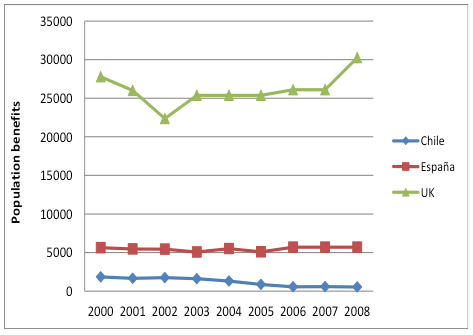
Source: The author
Based on the above data, it is not easy to determine what the index is in terms of the "ideal" number of benefits per inmate, which is essential if one wishes to understand "probation" as a prison benefit, which was incorporated at a later stage, such as in countries like Bolivia, Brazil, Colombia and Ecuador, Peru and Venezuela (CESC, 2006). At this stage, our results lead to the question whether the lowering of the figures for Chile was intentional, or whether it was a direct response to a more general phenomenon. For this reason, it was important to analyze the concentration of probation benefits per 100 inmates, which is shown on the next page in Table 3.
Table 3: Probation Figures per Number of Inmates
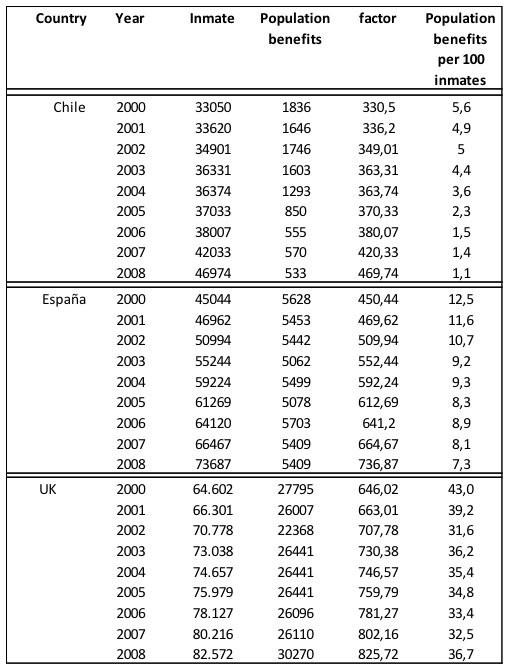
Source: The Author
Table 3 shows the concentration of probation for each country studied. The data are provided by the ratio of each 100 inmates, which leads to the conclusion that for the nine year study, the number of benefits reduced rapidly for both Chile and Spain. For the case of the UK, the reduction was moderate, but constant.
f) Benefits per 100 inmates
Graph 6 (created from Table 3) shows again that in both countries (Chile and Spain), the average rate of benefits (granted probation) has rapidly and considerably reduced. In the nine-year-study, the number of benefits for Chile fell to 79.6% per 100 inmates. In other words, almost double that of Spain. In the case of Spain, the figure dropped to 41.2%- providing the benefit of probation. One may infer from this that in Spain there has been a significant reduction in inmate benefits- just like in Chile. In the case of the UK, the real reduction has been variable –resulting in a policy that is both independent of the political factors of the country (the interim government), and because it is a more complex issue (involving legal systems, judges, prison ward staff, and inmates).
Graph 6: Prison benefits per 100 inmates
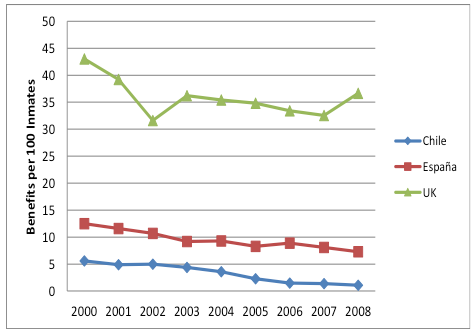
Source: The author
In the case of Spain, the reduction in probation period can be explained by Cid (2008). On the one hand, this indicates that there is a new legal framework. Despite the fact that it extends probation, it also reduces the number of potential candidates for probation. This fact is raised by Rivera (2006). Therefore, for the Spanish case study, there exists a restrictive state policy in the usage of probation. Other authors such as Tébas (2006) and Tamarit (2007) (highlighted by CID, 2008), point to a growing number of foreigners and the large-scale prisons as factors worth considering when evaluating the reduction of inmate benefits in Spain. Nevertheless, this situation has not been scientifically proven. In the case of Chile and lower probation rates, it should be highlighted that the political will of the interim government of Chile is what established this rate. At the same time, the Chilean Gendarmeries, based on technical data, reports to the Court of Appeal (ordinary justice), to obtain the corresponding data for each region (geographical area of Chile), and the justifications of potential candidates. These justifications, after being analyzed by the Judiciary, are sent to the respective Regional Secretaries of the Ministers of Justice (SEREMI). In order for it to be sanctioned (approval or rejection of a potential candidate's probation benefits), the roles of SEREMIS have to be designated at the presidential level.
For this nine-year study, this phenomenon would reflect the fact that the political will of the interim governments is not to grant excessive probation benefits. This would justify the scarce number of prison benefits (in Chile).
5. Conclusions
The mere fact that the figures for Chile have been reduced to 51,4% and that the investment gap per inmate plays a role in maintaining effective prison management, which is moderated to the UK levels, it is necessary to carry out a rigorous, comparative analysis of the management of the three countries- using as a reference the Chilean case study. In addition, it is a stark reminder of the question: What exactly should we compare between countries? This question is also highlighted by the fact that, in reality, Chile spends $2,89 more than the amount that is invested by Spain – that is, taking into account total investment per inhabitant (despite the fact that the figure for the UK is even greater than this).
The question How we should compare ourselves with other institutions can be corroborated in the writing up of this report- especially since we are talking about large numbers (macro variables). This is something that we should seriously consider if we are to carry out comparisons of the effectiveness of the various types of prison management in each of the three countries. In the specific case of Spain and the UK, and perhaps some other nations too, we should begin by looking at basic data, such as direct investment per inmate and the management of these resources.
In terms of why should we compare ourselves, the answer lies within the paradigms of science. It boils down to humankind and their quest for perfection, as well as recognizing their maximum potential on a comparative advantage level. Therefore, the institutions that meet these needs for prison management, should seek to perfect their objectives and to re-formulate their goals, placing as their ultimate benchmark the most developed nations- thus emulating their management system (North, 1990).
The mere fact that Chile has entered the OECD is a reflection of the above scenario. In light of these comparisons, we may argue that this study has made some important contributions to the discussions about Chilean and Spanish prison management, even though the UK is becoming a better model to follow- such as when determining the economic gap that exists between countries.
Moreover, it has been shown that both Chile and Spain lack recent socio-economic data to quantify aspects such as the inmates' reinsertion into society and other areas that are of interest to society- and which are also comparable.
Also, the investment variables per inmate versus benefits per inmate show that there is no direct relation between the increase in cost (investment) and the benefit of probation for inmates. For this reason, it should be stressed that the costs for the three countries is "social", or rather, that it mainly achieves one objective, i.e. "of incarcerating an individual", and by so doing, maintains a management of resources that is better geared towards the control of expenses, but without a plausible horizon of excessive prison benefits, and that takes into consideration differential factors. The latter point potentially reflects the increased investment by Chilean Gendarmeries in private prisons. In the future, this should provide more positive results in terms of social reinsertion. Indeed, in terms of security, this type of action ought to be covered by the State, namely through the Chilean Gendarmeries.
Similarly, Spain maintains a level of investment per inmate between $10,000 and 12,000. If we take this range as a reference point – without making Chile have a defined or currently visible range- Chile could aspire to generate a range that is similar to Spain´s. Notwithstanding, it generates a fairly consistent gap that is "not as equal". For the specific case of the UK, Chile should pay closer attention to its expenses and social investment in terms of penal regulations. However, for this study it would be the major model to follow.For example, maintaining a pace of continual investment between $6,000 and $8,000 per annum per inmate would reflect a real gap of (+-) 30% with respect to Spain, and a similar number to that of the UK- i.e. maintaining a gap of (+-) 80%. This would require a "relative socio-economic stability", where there is a balance between that which is invested and the results that one wishes to obtain. In this sense, the management of resources in Spain is a point of reference to follow in the short term. Consequently, the relationship with the UK is a point of reference in the long-term.
Second, the theme of prison benefits remains clearly unresolved for the three countries in this study. On the one hand, the authors highlighted in this study observe that the prison benefits derived from the restrictive policies from the interim governments and because of the actions that are deemed irrelevant from a legal/penal perspective. This situation can be seen within the context of the inmates, and/or the increase of foreign prisoners in certain cases. With a closer analysis from an economic perspective, i.e. where this situation of "red tape" is not perceived as being excessive, or where it is not solely analyzed in relation to the mechanisms of more effective social reinsertion mechanisms, it would be possible to achieve a more profound understanding of the current issues faced by prison management in the said countries.
Finally, although this study provides some important contributions to the subject matter, it is clear that certain aspects require further or deeper analysis. For example, the optimization of resources for investment for inmates (quality of investment), the rate of investment in percentages, and other variables that we have not been able to assess such as those that are related to rehabilitation efforts. Indeed, these lacunae in our findings largely exist because of a lack of information about prison statistics in the countries covered in this study. On the other hand, we should also ask ourselves if the concentration of resources per inmate was effective at the time of establishing some kind of rehabilitation –both for Spain and for Chile. Despite this, information concerning the UK prison system and management has been more readily available-making monitoring of the prison system more effective in the UK, and therefore a good model to follow.
Taking into account that certain aspects were not fully resolved in this study, we can conclude that future lines of research in this field are necessary, which could lead to additional comparative studies in Data Envelopment Analyses. For instance, in various regions of Chile (locally). By so doing, we would be able to identify the level of prison efficiency – according to internal variables of the Chilean Gendarmerie. These studies may likewise shed light on the economic efficiency, although it is clear that from the point of view of rehabilitation, it would not be possible to obtain reliable data in the short-term. As a result, the study of trends – to see the reality of prison term management for minor crimes and its fulfillment in the incarceration system- would help compare the human development indexes of the UNDP (internationally). Within the same context, it is important to consider the ability to create comparative studies of the private and public penitentiary systems – and their relationship with other international realities within Mercosur, Brazil, Argentina, Colombia, Chile etc. As a result, these comparative studies would contribute to knowledge development of economic aspects concerning income, employment, crime and policy making, which in turn would provide quality parameters to assess the influx in inmates in future prisons, and subsequently achieve the optimum number of prisons that a given society is capable of managing.
References
BANDES, E.; DÍEZ-TICIO, A. Delincuencia y acción policial: un enfoque económico, Revista de Economía Aplicada, vol. IX, N° 27, 5-33, 2001.
BECKER, G.S. Crime and punishment: an economic approach, Journal Of Polítical Economy, vol. 76, Nº 2, 169-217, 1968.
CABRAL, S.; AZEVEDO, P. The modes of provision of prison services in a comparative perspective, Brazilian Administration Review, vol. 5, N° 1, 2008.
CAMPOS, M. Escolha racional e criminalidade: uma avaliação crítica do modelo, Revista Seção Judiciária do Rio de Janeiro, R.SJRJ, RIO DE JANEIRO, n 22, p 93-101, 2008.
CESC. Centro de Estudios en Seguridad Ciudadana, Debates Penitenciarios, Universidad de Chile, [fecha consulta: 01 mayo 2010] Revista Electrónica nº6 en http://www.cesc.uchile.cl/pub_periodicas_dp_06.htm., 2006.
CID, J. El incremento de la población reclusa en España entre 1996-2006: diagnóstico y remedios, Revista Española de Investigación Criminológica, Artículo 2, N° 6. Disponible en www.criminología.net ISSN: 1696-9219, 2008.
DIDONET, S., DÍAZ, G. (2012) Supply Chain Management Practices as a Support to Innovation in SMEs, Journal of Technology Management & Innovation, Volume 7, Issue 3.
DIDONET, S., SIMMONS,G., DÍAZ-VILLAVICENCIO, G., PALMER M. (2012) The relationship between small business market orientation and environmental uncertainty. Marketing Intelligence & Planning, Vol. 30 Iss: 7 pp. 757 - 779
EHRLICH, I. Participation in illegitimate activities: a theorical and empirical investigation, Journal of Political Economy, vol. 81, Nº 3, pp. 521-567, 1973.
ENTORF, H., WINKER, P. Investigating the drugs–crime channel in economics of crime models Empirical evidence from panel data of the German States, International Review of Law and Economics, 28 (2008) 8–22, 2008.
FRANCIA, L. La protección de los derechos de las personas privadas de libertad: la defensoría del pueblo y la jurisprudencia del Tribunal Constitucional, Revista de Estudios Criminológicos y Penitenciarios, Ministerio de Justicia, Gendarmería de Chile, unidad de Investigación Criminológica, N° 9, 128p, 2006.
FUENTES, R.; GREDIG, F.; LARRAIN, M. La brecha de producto en Chile: medición y evaluación, Revista de Economía Chilena, Banco Central de Chile, vol. 11, N° 2, 2008.
GIBBONS, T. The utility of economic analysis of crime, International Review of Law and Economics (1982), 2 (173-191),1982.
HANCOCK, P.; RAESIDE, R. Modeling factors central to recidivism, an investigation od sentence management in the Scottish prison service, The Prison Journal, vol. 89, N° 1, 2009.
LAMBERT, E.; PAOLINE III, E. The influence of individual, job, and organizational characteristics on correctional staff job stress, job satisfaction, and organizational commitment, Criminal Justice Review, vol. 33, N° 4, 2008.
MARTÍN, J.; NAVARRO, J. Metodología econométrica para el análisis económico del delito. Los modelos de datos de panel, Revista Española de Investigación Criminológica, Artículo 3, N° 5. Disponible en www.criminología.net ISSN: 1696-9219, 2007.
NEWBOLD, P. Statistic for business & economics 4ª ed., Prentice hall, inc.ISBN 0-13-181595-4.UK, 1998.
NORTH, D. Instituciones, cambio institucional y desempeño económico, Fondo de cultura económica, México. Título original: Institutions, institutional change and economic performance. 1990, Cambridge University Press, 1990.
RIVERA, I. El tratamiento penitenciario y el laberinto punitivo-premial, en la legislación penitenciaria española, Revista de Estudios Criminológicos y Penitenciarios, Ministerio de Justicia, Gendarmería de Chile, unidad de Investigación Criminológica, N° 9,155p., 2006.
TAMARIT, J. M. Sistema de sanciones y política criminal, Revista Española de Ciencia Penal y Criminología 09-06. http://criminet.ugr.es//recpc., 2007.
TÉBAR, B. El modelo de libertad condicional español. Pamplona: Aranzadi, 2006.
VALDEMORO, M. Mantener un preso en España es un 46% más caro que en EEUU, Copyright Libertad Digital S.A. [fecha consulta: 03 mayo 2010] disponible en : http://www.libertaddigital.com/economia/ mantener-un-preso-en-espana-es-un-46-mas-caro-que-en-una-carcel-privada-de-eeuu-1276363300/, 2009.
Annex 1
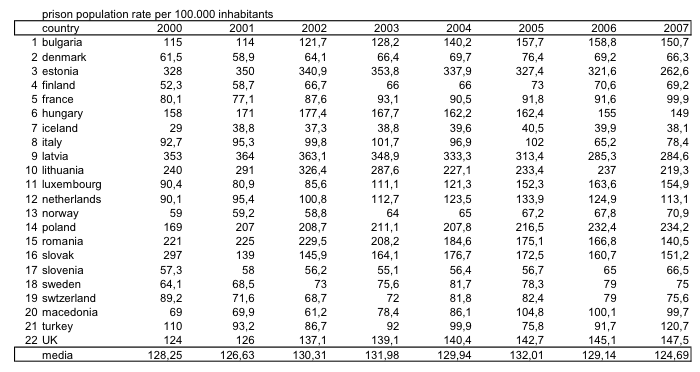
1 Ph.D. Economic and Business Latin American Institute of Economics, Sociology and Politics Universidade Federal da Integração Latino-Americana UNILA Foz do Iguaçu, Brazil Guillermo.diaz@unila.edu.br
2 Ms. Management and Social Development Department of Business Administration Universidad Técnica Particular de Loja UTPL Loja, Ecuador mfzumba@utpl.edu.ec
3
Ph.D. Administration Department of Administration, Faculty of Applied and Social Sciences Universidade Federal do Paraná UFPR Curitiba, Brazil simonedidonet@ufpr.br
4 BA Hons Department of Business Administration Universidad Técnica Particular de Loja UTPL Loja, Ecuador pmcahen@utpl.edu.ec
5 For further information, please see: http://www.un.org/en/documents/charter
6 Further information can be found at: http://www.kcl.ac.uk/schools/law/research/icps
7 Further information can be found at: http://www.coe.int
8 Further information can be found at: http://www.ncjrs.gov
9 Further information can be found at: http:http://www.ceoworks.org
10 Further information can be found at:http://www.psiru.org/justice
11 Further information can be found at: http://www.cesc.uchile.cl
12 Further information can be found at Vera Institute of Justice: http://www.vera.org
13 Further information can be found at Centre for Studies in Security and Citizenship (CESeC):http:www.ucamcesec.com.br
14 Further information can be found at the INDEM Foundation:http:www.indem.rujail
15 These are: the ISI Web of Knowledge, Dialnet, Scielo and Science Direct
16 The value of the US dollar has been taken from December of each year. Source: Central Bank of Chile
17 These costs do not take into consideration investment in prison infrastructure for the three countries.
18 In this study, we did not compute figures for "controlled probation"- as we lacked data for Spain.